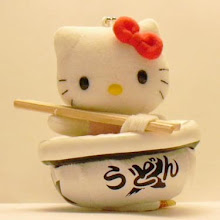The Elusive Regional Kitty

When I first started looking for Regional Limited Hello Kitty, my only guide at the time was Nyankovivi’s wonderous site. It should come as no surprise that her collection was a bit of a bible guide in my early auction searches. The site offers a gallery of genyo era regional/limited plushes. I would go through the gallery and look at some of the amazing regional plushes and make a list of the items I had to find.
After 6 months of trawling the web, I had amassed a collection that should have satisfied my needs. I was able to find some I'd seen in the gallery plus newer releases that were popping up on eBay. Granted, my list of gimmeez was considerably shorter than it once was, but there was a handful of plushes that never seemed to come up on the auction block. Maybe their absence gave me the illusion of special rarity, but all I knew was that I could not stop collecting until these few Kitties were found. Yes, my other regional Kitties were cute and interesting, but this elusive group was haunting me. To make matter worse, when I finally discovered the “official” regional site (Asunaro) it was apparent that these alleged rarities were no longer available – either sold out or no longer made. I should have given up, but those particular Kitties haunted my computer dreams.
In the following 6 months, at least 70% of those haunting Kitties made it to an auction. Yes, I paid more than I should have for a few, but I sleep better at night. Two of the Kitties were obtained through the generosity and sympathy of a fellow Kitty collector who found one in a Tokyo train station and the other up for auction on YahooJapan. Of course, this means there is at least one left that still taunts every now and then, but I think I can let go... for now.
I can't really say for sure why these particular Kitties hit me so hard. They may seem rather ordinary and indistinguishable from my other plushes. Maybe it was the fact that they somehow challenged me to a hunt? I don't know. I just really likedthem and I had to find them. So here they are:
REGION: KANTO/TOKYO –“TOKYO MEGUMI”

Kitty pays tribute to Tokyo Firemen. Kitty proudly carries the matoi, a big banner standard that was used as a firefighting tool by the firefighters or hikeshi of the Edo period. The strips of cloth on the matoi were soaked in water. A hikeshi would then climb up to a rooftop near the burning building. The hikeshi would then start to twist the matoi back and forth so it would release a spray of water. This spray and the current created by the twisting motion would help to either trap or put out any rising embers that threatened to land on other buildings in the area – an important consideration in a old city that was made primarily of wood, straw and paper.
If you’d like to see a matoi in action, this website has a few modern day demonstrations:
- http://www.nihonhikeshihozonkai.org/news/news.html
(Requires Windows Media Player)
REGION: TOKYO/TOKYO – “INU HARIKO”

Kitty appears as a version of the Inu Hariko, or paper-mache dog. This is a talisman that focuses on the protection of children. For pregnant mothers, the Inu Hariko is said to ensure a safe and easy birth and that the newborn will be strong. For their children, it protects them from evil. After all, dogs are still regarded as the guardians of our homes in these modern times. In addition, dogs are thought to have the ability to recognize evil – all dog owners at one time or another swear they once had a dog that could smell trouble! In this Tokyo version, Kitty’s Inu Hariko carries a denden taiko, a double headed drum that is also a child’s toy. The drum is also meant to be a talisman against evil spirits.
REGION: KANSAI-KINKI – “WAKAYMA PLUM”

Kitty mugs for the camera as she wrestles with the nanko ume – the king of plums. These famous Wakayma plums will be used to make the highly regarded umeboshi. The plum is pickled in a salt brine then aged. The result is a very salty, tangy “slap-in-the-face” taste, which probably explains Kitty’s expression.
REGION: HORIKURU – “KANAZAWA SUMMER & WINTER YUUZEN”

Dressed in a two formal kimonos, Kitty displays Kanazawa’s famous Kaga Yuuzen or the art of silk dying. This is a complex process that combines a number of different techniques including stenciling, blocking and painting. Nature-themed motifs are traced on fine silk with a line of juice from the aobana flower. Then the aobana line is covered with a rice-paste that will keep the dye from bleeding out of the design lines. Then the hand painting is done. Another layer of rice-paste is applied which allows certain gradation of colors and to protect the design as the material heads into its “background color” dying. The silk is then rinsed in water to wash away the paste, then steamed to fix in the dye and rinsed one last time to wash away any remaining paste.
Of personal note: Kitty holds a temari ball. When I was very little my sisters were given large temari or thread balls. I was fascinated with them and had the strongest urge to take a pair of scissors to them and unravel all that thread. Fortunately, no one every gave me the chance to act out my moment destructive of curiosity


0 Comments:
Post a Comment
<< Home